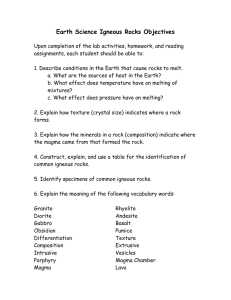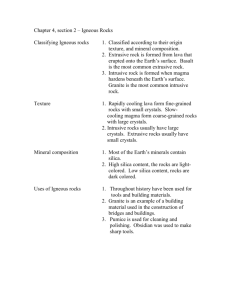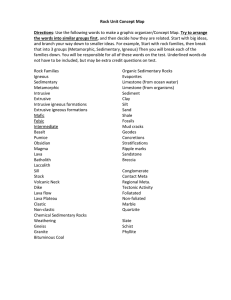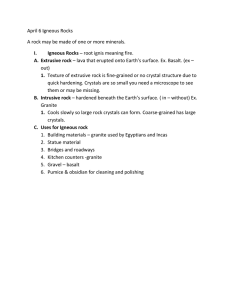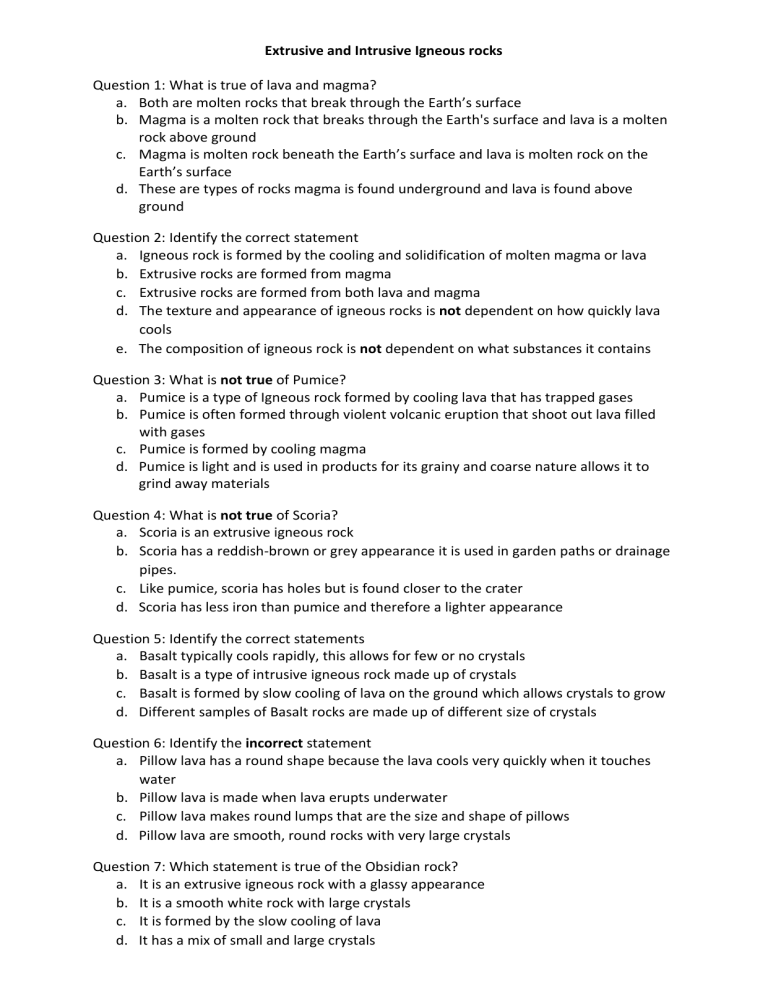
Extrusive and Intrusive Igneous rocks Question 1: What is true of lava and magma? a. Both are molten rocks that break through the Earth’s surface b. Magma is a molten rock that breaks through the Earth's surface and lava is a molten rock above ground c. Magma is molten rock beneath the Earth’s surface and lava is molten rock on the Earth’s surface d. These are types of rocks magma is found underground and lava is found above ground Question 2: Identify the correct statement a. Igneous rock is formed by the cooling and solidification of molten magma or lava b. Extrusive rocks are formed from magma c. Extrusive rocks are formed from both lava and magma d. The texture and appearance of igneous rocks is not dependent on how quickly lava cools e. The composition of igneous rock is not dependent on what substances it contains Question 3: What is not true of Pumice? a. Pumice is a type of Igneous rock formed by cooling lava that has trapped gases b. Pumice is often formed through violent volcanic eruption that shoot out lava filled with gases c. Pumice is formed by cooling magma d. Pumice is light and is used in products for its grainy and coarse nature allows it to grind away materials Question 4: What is not true of Scoria? a. Scoria is an extrusive igneous rock b. Scoria has a reddish-brown or grey appearance it is used in garden paths or drainage pipes. c. Like pumice, scoria has holes but is found closer to the crater d. Scoria has less iron than pumice and therefore a lighter appearance Question 5: Identify the correct statements a. Basalt typically cools rapidly, this allows for few or no crystals b. Basalt is a type of intrusive igneous rock made up of crystals c. Basalt is formed by slow cooling of lava on the ground which allows crystals to grow d. Different samples of Basalt rocks are made up of different size of crystals Question 6: Identify the incorrect statement a. Pillow lava has a round shape because the lava cools very quickly when it touches water b. Pillow lava is made when lava erupts underwater c. Pillow lava makes round lumps that are the size and shape of pillows d. Pillow lava are smooth, round rocks with very large crystals Question 7: Which statement is true of the Obsidian rock? a. It is an extrusive igneous rock with a glassy appearance b. It is a smooth white rock with large crystals c. It is formed by the slow cooling of lava d. It has a mix of small and large crystals Question 8: Which is true of intrusive igneous rocks and/or intrusive igneous rocks? a. Intrusive igneous rocks cool rapidly and form small crystals b. Large bodies of intrusive rocks have no crystals c. Intrusive rocks have large crystals because their crystals have had more time to grow d. None of the above Question 9: Which statement is true of basalt? a. It is formed from pebbles and is therefore a conglomerate rock b. It is formed from volcanic lava and is an example of an igneous rock c. It is formed from igneous rock that has experienced high heat and pressure d. It is molten lava found underneath the earth’s crust Question 10: Why are there many holes in Pumice rocks? a. The holes are formed because not all pebbles can cement together b. The holes are formed by fossils that are melted away by lava c. Gases are trapped by molten lava that cools rapidly, the escape gases form holes d. Pumice rocks are formed under water, as water cools the rock, holes are formed Question 11: Complete the diagram to classify the types of igneous rocks given below. Pumice, Basalt, Scoria, Obsidian, Granite, extrusive, intrusive. Question 12: Which of the following is true of extrusive and intrusive igneous rocks? a. Intrusive rocks are generally formed above the earth surface and extrusive are formed below the earth surface b. Igneous intrusive rocks tend to have larger crystals than extrusive igneous rocks as they have had time to cool c. There is no difference between extrusive and intrusive igneous rocks d. None of the above Question 13: Label the two types of igneous rocks below.



